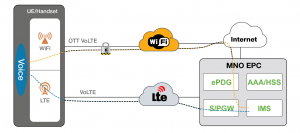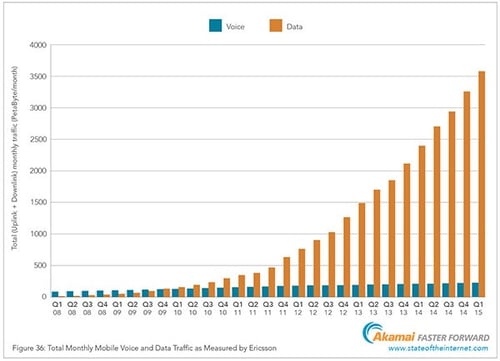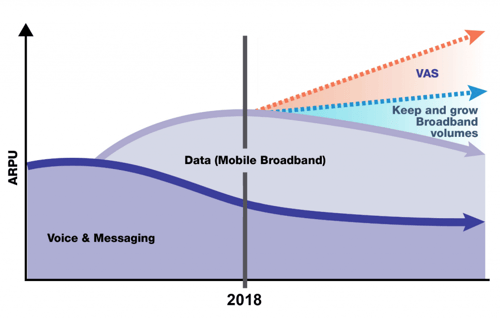
Blog
Business Calling Shifts to the Smartphone
In the 2000’s everyone moved from PSTN to IP PBXs and VoIP desk phones. Then, as we embraced smartphones and started doing more things on them, taking business calls on them was a foregone conclusion. Over the last decade, there has been a steady growth in the number of people who no longer use their desk phones, and now conduct all day-to-day business on their personal smartphones, even when at their desk.
These days with almost any implementation of IP PBX, an enterprise user can have calls routed to the handset of their choice, including their personal smartphone. So there has been a gradual migration of business VoIP voice traffic away from enterprise networks to cellular. This being the result of more and more people preferring to take business calls on their smartphone as the handset of choice, no matter what number the call was made to.
 Enterprise VoIP migration to cellular
Enterprise VoIP migration to cellular
VoIP Over Wi-Fi is Nothing New
While corporate voice traffic (VoIP) on the LAN may be slowly eroding, VoIP traffic as a whole has been growing fast, as other OTT (Over the Top) VoIP applications have taken hold. Sanctioned or otherwise, many employees use Skype, Zoom, Join.me, WhatsApp and a horde of other free and paid web conferencing applications. All of these use some flavor of VoIP when you do the audio over the Internet, instead of dialing into a bridge. And much of this traffic is of course going over Wi-Fi.
In several industries voice is also going over Wi-Fi using purpose-built VoIP devices. For example in healthcare, caregivers use Wi-Fi phone handsets and voice communicators. Likewise in hospitality, staff may use Wi-Fi phones instead of walkie-talkies, and in the supply chain, wireless audio and augmented-reality headsets are used by warehouse pickers and packers.
What's Wi-Fi Calling All About?
Wi-Fi calling allows Mobile Network Operators (MNOs) to extend voice and SMS coverage to subscribers anywhere there is a Wi-Fi signal available or where cellular coverage is poor, by effectively turning any Wi-Fi access point into a virtual cell tower. The result is fewer dropped calls, better connectivity, less interference and a greater call completion rate (CCR). That’s a win-win for consumers and operators alike!
If they could get their subscribers to make ALL of their calls over Wi-Fi, mobile operators could theoretically offer a cellular service, without having a cellular network at all. In fact there are a number of Wi-Fi First pioneers such as Republic Wireless, who do just that. They use Wi-Fi as their default mobile-network technology, falling back on cellular only when necessary. They don’t own any network at all, instead they operate as MVNOs leasing bulk access to Verizon, Sprint, O2 or someone else’s cellular network for the calls that need cellular service. It’s a pretty clever idea.
OTT VoIP versus Wi-Fi Calling
The problem with OTT VoIP applications is that they are not tightly integrated with the phone, nor can they become part of your corporate phone system and dial plan. They are closed systems wherein you can only reach other members of the same application or service, not just anyone with a phone.
If all you want to do is talk, they are clumsy and limited. Whereas, with Wi-Fi calling, having Wi-Fi access only, one can place or receive a call, send or receive a SMS, in the same way and using the same dialer or messaging interface that one normally uses for cellular calls.
This approach is more potent than OTT VoIP applications because cellphones are part of a global public switched telephone network (PSTN) that lets you reach anyone, just by knowing their number. True, there is no video or screen sharing component as you have in say Skype, but that too, is coming.
So the idea of Wi-Fi calling is to let cellphones use Wi-Fi instead of cellular to join a mobile caller to the mobile network, and from there to still be able reach anyone else in the PSTN, just as they do now. But that’s just the beginning. In future, you'll be able to do anything multimedia, with the same degree of simplicity, according to the feature sets available on each device.
 VoLTE vs. Wi-Fi calling, source: Ruckus Wireless
VoLTE vs. Wi-Fi calling, source: Ruckus Wireless
Will Business Voice Calling Return to the LAN?
Does that mean: if Wi-Fi calling takes off, and mobile users start making PSTN calls over Wi-Fi from their smartphones, then business voice traffic will migrate back to the corporate network? Yes! – exactly. But it may not be limited to business calls. Now you may end up carrying personal calls over your LAN as well, on behalf of MNOs. Hence the overall amount of VoWi-Fi traffic may be significantly higher than it is now.
Has it begun already? With approximately 80% of enterprises supporting BYOD programs it is inevitable that savvy Wi-Fi calling users have already begun using it, and as it becomes popularized - it will grow.
What’s in it for MNOs?
Major MNOs have invested big bucks in the development of Wi-Fi calling capabilities. With most U.S. and E.U. MNOs launching the capability in 2015 and 2016.
Saving minutes and getting better call quality are obvious benefits for the consumer. In fact, given that most users are in range of Wi-Fi most of the day, it's truly possible to reduce the number of calls that go over the cellular network by 80-90%.
Many mobile plans are designed to encourage Wi-Fi calling. Operators can claw the revenue from those lost minutes back in other ways, including charging for Wi-Fi calling as an option. They’ll find a way. You know how good they are at making something appear free, when it really isn’t!
The challenge MNOs face is that mobile data is doubling every 12-18 months, whereas voice is hardly growing at all. The money is in data services and value-added services on top of that. Not voice. In fact, as LTE is more widely deployed, the price for voice services will continue to fall.
 Mobile Voice and Data Growth, source Ericsson
Mobile Voice and Data Growth, source Ericsson
For these reasons, this is less about monetizing Wi-Fi calling than it is about off-loading voice from the cellular network. In the US, mobile data revenues surpassed mobile voice revenues in 2014. The same is likely for most of Northern Europe too. Each successive year, voice revenue becomes a smaller piece of the pie as the average revenue per [voice] user (ARPU) continues to fall. Yet voice still consumes a lot of precious bandwidth especially on legacy 2G and 3G networks.
 ARPU life cycle for voice and data
ARPU life cycle for voice and data
Mobile operators want to maximize their mobile network capacity for data traffic which gives them a better ROI on their infrastructure. Cellular radio spectrum is incredibly expensive, so anything MNOs can do to get unprofitable traffic off their network helps to extend its life. Wi-Fi calling is one such measure.
But there are technical reasons why the major operators are putting money behind Wi-Fi calling, and those are related to their slow and steady march toward LTE/IMS core networks. In addition to greater bandwidth, LTE delivers a huge leap in efficiency over former circuit switched 2G and hybrid 3G networks, because it is fully packet switched. Hence, LTE is a stepping stone to IMS (IP Multimedia Subsystem or IP Multimedia Core Network Subsystem).
Explaining the merits and the state of the market of IMS is a subject in itself, for another blog perhaps… but a simple way to describe it is: Imagine Skype, WebEx or WhatsApp being fully integrated with your phone contacts, and you being able to pick a name or dial a number and then start a native video call (and much more) with another party on any device or service providers network.
This is much the same as what you can do today for voice and partially so for SMS. With Wi-Fi calling, from your mobile device you can call any type of phone on any Service Provider’s network anywhere in the world.
Is All Wi-Fi Calling the Same?
Needless to say, implementations vary. Wi-Fi calling may be activated when a phone cannot get good cell signal, or simply whenever it is connected to a suitable Wi-Fi network. When the cellular connection is LTE, the solution is elegant, as voice-over-LTE and Wi-Fi are both packet based. The phone simply switches the IP packets from one network interface to the other.
But some operators have implemented Wi-Fi calling over non-LTE connections (2G, 3G), which is more complicated, because the cellular side is not IP-based. This means mobile operators must add VoIP and SMSoIP gateways and other types of technology to their network, and they must be able to terminate IPSec tunnels to ensure secure and continuous service over unknown access points and untrusted connections.
In most implementations today, it's only possible to switch to Wi-Fi at the beginning of a call, and you cannot roam freely between Wi-Fi and cellular. But this is beginning to change. Additional middleware and new standards such as IMS make it possible to roam mid-call from cellular to Wi-Fi and vice-versa.
The beauty of Wi-Fi Calling is it offloads voice and SMS traffic from the cellular network by using VoIP over Wi-Fi, but it still gives you access to anyone with a phone. As this evolves to IMS it means you could be doing multimedia communication with anyone, on any device, just by dialing their number. And they won’t need to be members of any specific service.
Don’t Be Scared, Be Prepared!
The bandwidth requirements for a single Wi-Fi calling VoIP call are about 100K each way. With the speeds now available with 802.11 AC, you’d think supporting Wi-Fi calling and other VoIP applications should be a cake-walk. But there’s more to it than that.
Real-time traffic is very susceptible to: Packet Loss (some % of sent packets not being received), Latency: The end-to-end delay for a packet, and Jitter: the variance in latency. Having access to sufficient bandwidth is no guarantee that the packet loss, latency and jitter is within acceptable ranges throughout your facility.
The only way to know, is to do spot tests in different locations as frequently as possible. But conducting regular site surveys is simply not practical. Even if it were, qualifying your Wi-Fi network suitability for voice is more complicated than waving a spectrum analyzer around. It requires some form of client server performance testing – not so easy to do on a scale that tells you the wireless health in every nook and cranny in your building.
Wi-Fi Performance Testing
That’s why so many organizations are turning to performance management testing tools like 7SIGNAL's Mobile Eye to leverage their users to crowdsource performance samples from different areas of their facilities. Enterprises can leverage existing BYOD and Mobile Device Management policies to distribute the Mobile Eye app or agent to any mobile device that is authorized to use the network.
Thereafter, as users move around, Mobile Eye periodically performs a suite of tests to evaluate MOS score and other voice-related metrics. This all happens in the background, feeding a cloud analytics engine with an endless supply of samples from wherever people actually go in the facility.
So all you have to do is establish the performance thresholds you want to maintain, and Mobile Eye tells you when an area isn't up to par. This gives you time to do something about it, before it gets bad enough for users to notice.